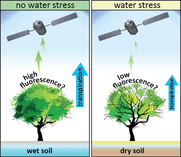Sensing global ecosystem stress
Accurate, large-scale observations of plant stress are needed to improve modelling of global ecosystem transpiration and photosynthesis, and the implications of vegetation stress for the global carbon and water cycles.
These observations may already be available: today, novel satellite instruments can sense chlorophyll fluorescence, a subtle glow of energy emitted by the chemical reactions that occur during photosynthesis. This glow may, a priori, be sensitive to plant stress.
How do we step up

Our research is in line with the European Space Agency (ESA) top priorities, in anticipation of the launch of the first fluorescence-dedicated satellite mission, FLEX.
